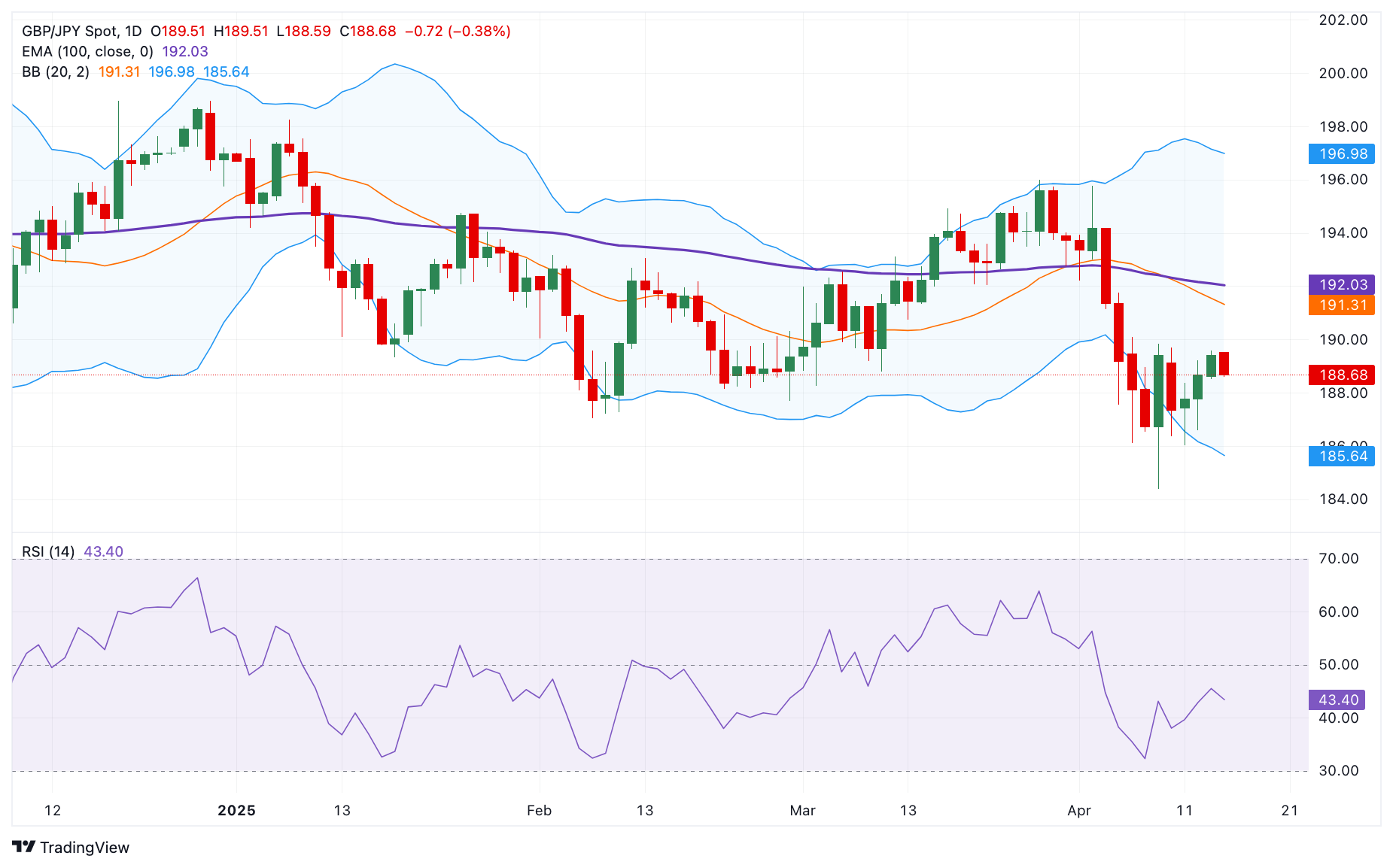GBP/JPY Price Forecast: Bearish outlook remains intact below 189.00
- GBP/JPY softens to near 188.80 in Wednesday’s early European session, down 0.31% on the day.
- The cross keeps the negative outlook below the 100-day EMA with a bearish RSI indicator.
- The initial support emerges at 186.55; the crucial upside barrier is located at 190.00.
The GBP/JPY cross attracts some sellers to around 188.80 during the early European session on Wednesday. The Pound Sterling (GBP) weakens against the Japanese Yen (JPY) after the UK Consumer Price Index (CPI) inflation report.
The UK Consumer Price Index (CPI) rose 2.6% YoY to March, an easing from the 2.8% increase in February, according to the Office for National Statistics on Wednesday. It was the weakest inflation since December 2024 and below the market consensus of 2.7%. Meanwhile, the Core CPI, which excludes the volatile prices of food and energy, rose 3.4% YoY in March versus 3.5% prior, in line with the market consensus of 3.4%.
According to the daily chart, the bearish outlook of GBP/JPY remains in play as the cross remains capped below the key 100-day Exponential Moving Average (EMA). Furthermore, the downward momentum is supported by the 14-day Relative Strength Index (RSI), which is located below the midline near 44, suggesting that the path of least resistance is to the downside.
The first downside target for the cross emerges at 186.55, the low of April 8. Extended losses could see a drop to 185.65, the lower limit of the Bollinger Band. A decisive break below the mentioned level could pave the way to 184.37, the low of September 13, 2024.
On the bright side, the immediate resistance level for the cross is located at the 190.00 psychological mark. Sustained trading above this level could attract some buyers to 192.05, the 100-day EMA. Further north, the next hurdle is seen at 194.19, the high of April 3.
GBP/JPY daily chart

Pound Sterling FAQs
The Pound Sterling (GBP) is the oldest currency in the world (886 AD) and the official currency of the United Kingdom. It is the fourth most traded unit for foreign exchange (FX) in the world, accounting for 12% of all transactions, averaging $630 billion a day, according to 2022 data. Its key trading pairs are GBP/USD, also known as ‘Cable’, which accounts for 11% of FX, GBP/JPY, or the ‘Dragon’ as it is known by traders (3%), and EUR/GBP (2%). The Pound Sterling is issued by the Bank of England (BoE).
The single most important factor influencing the value of the Pound Sterling is monetary policy decided by the Bank of England. The BoE bases its decisions on whether it has achieved its primary goal of “price stability” – a steady inflation rate of around 2%. Its primary tool for achieving this is the adjustment of interest rates. When inflation is too high, the BoE will try to rein it in by raising interest rates, making it more expensive for people and businesses to access credit. This is generally positive for GBP, as higher interest rates make the UK a more attractive place for global investors to park their money. When inflation falls too low it is a sign economic growth is slowing. In this scenario, the BoE will consider lowering interest rates to cheapen credit so businesses will borrow more to invest in growth-generating projects.
Data releases gauge the health of the economy and can impact the value of the Pound Sterling. Indicators such as GDP, Manufacturing and Services PMIs, and employment can all influence the direction of the GBP. A strong economy is good for Sterling. Not only does it attract more foreign investment but it may encourage the BoE to put up interest rates, which will directly strengthen GBP. Otherwise, if economic data is weak, the Pound Sterling is likely to fall.
Another significant data release for the Pound Sterling is the Trade Balance. This indicator measures the difference between what a country earns from its exports and what it spends on imports over a given period. If a country produces highly sought-after exports, its currency will benefit purely from the extra demand created from foreign buyers seeking to purchase these goods. Therefore, a positive net Trade Balance strengthens a currency and vice versa for a negative balance.

